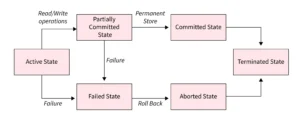Transaction States
In a database system, every transaction goes through a series of well-defined states during its execution. Understanding these states is essential for managing transaction control, detecting errors, and maintaining data consistency and integrity.

The typical transaction lifecycle consists of the following main states:
1. Active State
A transaction enters the Active state when it starts executing. In this phase, it performs all the necessary operations such as reading, writing, and computing. As long as the transaction is progressing without errors, it remains in this state.
Example: A banking system starts a transaction to transfer money between two accounts. The steps to fetch account balances and apply changes are performed in this state.
2. Partially Committed State
After completing all the operations, the transaction moves to the Partially Committed state. This means that it has reached the point where it is ready to commit, but the changes are not yet permanent in the database.
At this stage, the system performs final checks (e.g., verifying constraints and logging the changes) before making a permanent update.
If everything goes well, the transaction will proceed to the next state. If a failure occurs, it will be aborted.
3. Committed State
Once the system successfully validates and stores all changes, the transaction enters the Committed state. In this state, all updates made by the transaction become permanent and visible to other transactions.
Even if the system crashes after this point, the database must be able to recover and reflect the committed changes.
This state reflects successful completion and durability of the transaction.
4. Failed State
A transaction enters the Failed state when it encounters an error or violation that prevents it from completing successfully. This could happen due to:
- System crashes
- Logical errors
- Constraint violations
In this state, the DBMS ensures that none of the changes made by the transaction are reflected in the database. If some operations were already performed, the system rolls them back.
5. Aborted State
After a transaction fails, it is moved to the Aborted state. This means the DBMS has undone all the changes made by the transaction, and the database has been restored to its original, consistent state.
- If possible, the transaction may be restarted automatically.
- If not, it is permanently terminated.
Visual Representation (Lifecycle):
Summary
Transaction states help in managing the complete life cycle of a transaction. They ensure that either all changes are fully applied or none at all. By tracking transitions between these states, the database system maintains its reliability, consistency, and fault tolerance.